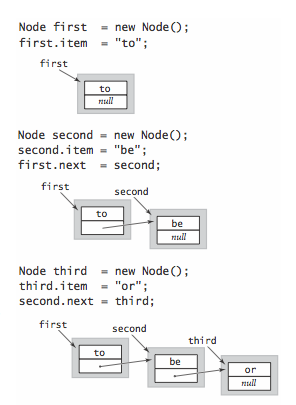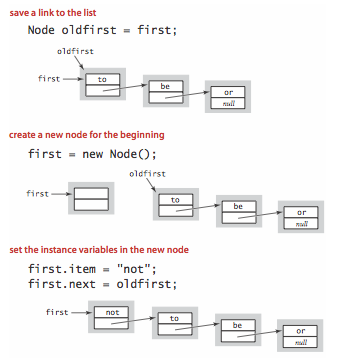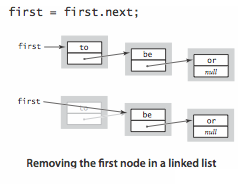介绍
定义:链表是一种递归的数据结构,它或者为空(null),或者是指向一个结点(node)的引用,该结点含有一个泛型的元素和一个指向另一条链表的引用。
结点是一个可能包含任意类型数据的抽象实体,它所包含的指向结点的应用显示了它在构造链表之中的作用。
结点
1 | private class Node{ |
一个Node对象含有两个实例变量,类型分别为Item(参数类型)和Node。
- Item是一个占位符,表示我们希望用链表处理的任意数据类型;
- Node类型的实例变量显示了这种数据结构的链式本质,调用的结果是一个指向Node对象的引用。
构造链表
根据递归定义,我们需要一个Node类型的变量就能表示一条链表,只要保证它的值是null或者指向另一个Node对象并且该对象的next域指向了另一条链表即可。用链接构造一条链表如下图:

例:构造一条含有元素:to、be和or的链表:
1 | //首先为每个元素创造一个结点 |
first,second,third都是一条链表,都是对应的一个结点的引用,third该结点指向null,是一个空链表。
在表头插入结点
先将first保存在oldfirst中,再将一个新结点赋予first,并将它的item设为将要添加的值,next域设为oldfirst。在链表的开头插入一个新结点如图:

例:给链表开头插入字符串not:
1 | //先将first保存在oldfirst中 |
在链表开头插入一个结点只需要几行赋值语句,所以它所需的时间和链表的长度无关。
从表头删除结点
执行要将first指向first.next即可。删除链表的首结点如图:

例:删除链表的首结点:
1 | //只需将first指向first.next |
该操作只含有一条赋值语句,因此运行时间和链表的长度无关。删除链表首结点有可能改变指向链表尾结点的引用,因为当链表中只有一个结点时,它既是首结点,又是尾结点。
在链表尾部插入结点
先将last保存在oldlast中,再将一个新结点赋予last,并将它的item设为将要添加的值,再将oldlast的next域设为last。在链表尾部插入新结点如图:

例:在链表尾部插入结点:
1 | //保存指向尾结点的链接 |
这段代码无法处理链表为空的情况,它会使用空链接,所以修改链表的操作需要添加检查。
其他操作
- 删除指定的结点;
- 在指定结点前插入一个新结点等。
这些情况就不那么容易,例如删除链表的尾结点,现有的解决方法就是遍历整条链表,找到指向尾结点的结点链接,将它的值设为null。该操作所需的时间与链表的长度成正比。实现任意插入和删除操作的标准解决方案是使用双向链表。
链表遍历
将循环的索引变量x初始化为链表的首结点,然后通过x.item访问和x相关联的元素,并将x设为x.next来访问链表中的下一个结点,直到x为null为止。
1 | for(Node x = first; x != null; x = x.next){ |
链表实现栈
将栈保存为一条链表,栈的顶部即为表头,实例变量first指向栈顶,当push()压入一个元素,将该元素添加在表头,当pop()删除一个元素时,将该元素从表头删除。该链表的使用达到最优的设计目标:
- 它可以处理任意类型的数据;
- 所需的空间总是和集合的大小成正比;
- 操作所需的时间总是和集合的大小无关。
1 | //链表实现下压栈 |
这份泛型的Stack实现的基础是链表数据结构,它可以用于创建任意数据类型的栈,并支持迭代。
链表实现队列
将队列表示为一条从最早插入元素到最近插入的元素的链表,first指向队列的开头,last指向队列的结尾,入列操作enqueue()将元素添加到表尾(当链表为空时,需要将first和last都指向新结点),出列操作dequeue()将表头元素删除(只是当链表为空时需要更新last的值)。同栈一样,也达到了最优设计目标。
1 | //链表实现队列 |
这份泛型的Queue实现的基础是链表数据结构,它可以用于创建任意数据类型的队列,并支持迭代。
链表实现背包
用链表实现背包只需将栈的push()改名为add(),并去掉pop()方法即可。
1 | //链表实现下压栈 |